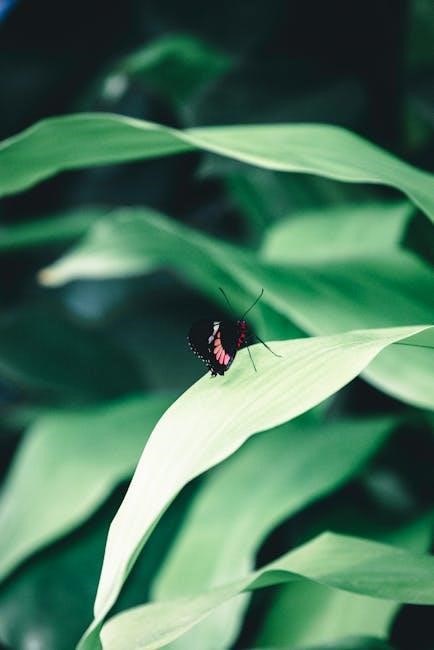The National Geographic Butterfly Kit offers a hands-on educational experience, allowing kids to raise and observe Painted Lady butterflies from caterpillar to winged adult. Includes habitat, caterpillar voucher, feeder, and educational materials for a perfect learning experience.
Overview of the Kit Components
The National Geographic Butterfly Kit includes a mesh habitat with a see-through lid, a voucher for 5 live caterpillars, a butterfly feeder, feeder dish, sponge, and detailed instructions. Additional components are stickers for decorating the feeder and a full-color poster explaining the life cycle and anatomy of butterflies. The kit provides everything needed to create a nurturing environment for caterpillars to transform into Painted Lady butterflies, making it an engaging educational tool for kids and families.
Importance of Following Instructions
Following the instructions provided with the National Geographic Butterfly Kit is crucial for ensuring the health and successful transformation of your caterpillars. The kit includes specific guidelines for setting up the habitat, caring for the caterpillars, and monitoring their growth. Adhering to these steps helps maintain proper temperature, ventilation, and feeding schedules, which are essential for the butterflies to thrive. By following the instructions carefully, you can avoid common mistakes and create an optimal environment for this educational and rewarding experience.
Unboxing and Initial Setup
Begin by carefully unboxing the National Geographic Butterfly Kit, which includes a habitat, caterpillar voucher, feeder, and instructions. Place the jar in a safe, upright location away from direct sunlight and drafts to ensure the caterpillars thrive.
Examining the Habitat and Accessories
Examine the habitat, a mesh enclosure with a clear lid, designed for ventilation and observation. Locate the feeder dish, sponge, and stickers for decoration. Ensure all accessories are intact and ready for use. The habitat is sturdy, with tiny holes in the caterpillar cup for airflow. This setup creates an ideal environment for the caterpillars to grow and transform into butterflies, providing a safe and educational space for kids to learn about metamorphosis.
Redeeming the Caterpillar Voucher
Redeem the included voucher online to receive 5 live caterpillars, often arriving with an extra as a bonus. Follow the instructions provided to complete the redemption process. This step is crucial for starting your butterfly-raising journey. The caterpillars will be shipped to your doorstep, ready to begin their transformation. Ensure the voucher is redeemed promptly to guarantee the arrival of healthy larvae, which will grow into Painted Lady butterflies under proper care.

Caring for Caterpillars
Proper care involves keeping the caterpillar cup upright, away from direct sunlight, and maintaining a safe environment. Follow instructions for feeding and monitoring growth daily.
Placing the Caterpillar Cup in the Refrigerator
Place the caterpillar cup in the refrigerator for 20-30 minutes to slow their activity, making them easier to handle. Ensure the cup remains upright to prevent food contamination. Avoid direct sunlight and cold drafts, as this can harm the caterpillars. Refrigeration helps maintain their health and slows growth temporarily. Do not freeze, as this will damage the caterpillars. Always follow the provided instructions for proper care and handling.
Monitoring Caterpillar Growth and Health
Check caterpillars daily for growth, ensuring they are molting, eating, and producing frass. Clean the cup as needed to maintain a healthy environment. Monitor for signs of stress or illness, such as lethargy or discoloration. Ensure caterpillars are active and properly fed. This careful observation helps guarantee healthy development and successful transformation into butterflies. Regular monitoring is crucial for a successful experience with your National Geographic Butterfly Kit.

Building the Butterfly Habitat
The National Geographic Butterfly Kit includes a mesh enclosure with a see-through lid, designed to create a safe and observable environment for butterflies to emerge and fly.
Assembling the Mesh Enclosure
To assemble the mesh enclosure, carefully attach the sides and top using the provided connectors. Ensure all edges are securely fastened for a stable structure. Place the habitat on a flat, stable surface, away from direct sunlight or drafts. The see-through lid allows for clear observation of the butterflies as they emerge and fly. This step is crucial for creating a safe and visible environment for your butterflies to thrive.
Decorating the Butterfly Feeder
Use the included stickers to personalize the butterfly feeder, making it visually appealing for both kids and the butterflies. The feeder’s design allows for easy decoration while ensuring functionality. Once decorated, fill the feeder dish with sugar water using the provided sponge. This step not only adds creativity but also prepares the habitat for feeding the adult butterflies. Encourage kids to get creative while learning about the importance of proper feeding habits for these beautiful creatures.
Feeding and Maintaining the Habitat
Use the feeder dish and sponge to provide a sugar water mixture for adult butterflies. Regularly refresh the solution to ensure cleanliness and prevent mold growth.
Using the Feeder Dish and Sponge
To feed your butterflies, mix a sugar water solution (4 parts water to 1 part sugar) in the feeder dish. Soak the sponge in the mixture and place it in the dish. Position the feeder inside the habitat, ensuring easy access for the butterflies. Replace the solution every 2-3 days to prevent mold. Clean the feeder dish regularly with mild soap and water to maintain a healthy environment for your butterflies.
Ensuring Proper Ventilation and Temperature
Proper ventilation is essential for maintaining a healthy environment for your butterflies. Ensure the mesh enclosure remains open slightly to allow airflow while preventing escape. Keep the habitat away from direct sunlight and drafts to avoid overheating or chilling. Maintain a stable room temperature of 65-75°F for optimal development. Avoid extreme temperature fluctuations, as they can harm the butterflies. Regularly monitor the habitat’s conditions to ensure a balanced and safe environment for your caterpillars and butterflies to thrive.
Observing the Transformation
Witness the magical journey from caterpillar to butterfly, understanding the life cycle stages. Expect transformation within 3 weeks, with butterflies emerging fully formed and ready to fly.
Understanding the Life Cycle Stages
The life cycle of a butterfly includes four stages: egg, caterpillar, chrysalis, and adult. Eggs hatch into caterpillars, which eat and grow before forming a chrysalis. Inside, a remarkable transformation occurs, culminating in a fully formed butterfly emerging. This process typically takes about three weeks. The resulting butterflies usually live for two to four weeks. Observing these stages provides a fascinating educational experience, teaching kids about metamorphosis and nature’s wonders. Regular observation helps track progress and ensures a successful transformation.
Recognizing Signs of Chrysalis Formation
As caterpillars prepare to form a chrysalis, they slow down, stop eating, and attach themselves to a surface. You may notice them hanging upside down or curled up. This signals the start of transformation. The chrysalis stage usually lasts about two weeks. During this time, avoid disturbing the chrysalis, as it is a critical period. Keep the habitat stable and observe patiently. Once the chrysalis starts to crack, a beautiful butterfly will emerge, ready to begin its new life cycle.
Troubleshooting Common Issues
If a chrysalis falls, gently reattach it using a small dab of honey or sugar water. For caterpillar care challenges, ensure proper food and habitat conditions.
What to Do if a Chrysalis Falls
If a chrysalis falls, handle it gently to avoid damage. Attach it to a safe surface using a small dab of honey or sugar water. Ensure the chrysalis is secure and upright in the habitat. Monitor it closely for signs of emergence. If the chrysalis appears undamaged, the butterfly should still emerge normally. Keep the habitat stable and avoid direct sunlight or drafts during this critical stage.
Addressing Caterpillar Care Challenges
Ensure caterpillars are kept in a clean, well-ventilated area. Avoid direct sunlight and drafts. If caterpillars appear sluggish, check the temperature and food supply. Replace food if moldy. Handle caterpillars gently to prevent injury. If issues persist, consult the provided care guide or contact customer support for assistance. Maintain a safe environment to promote healthy growth and successful transformation into butterflies.

Releasing the Butterflies
Release butterflies in a calm, sunny spot away from predators. Ensure they are fully active and dry before setting them free. Provide nectar-rich flowers nearby.
Preparing for Release
Before releasing your butterflies, ensure they are fully active and dry. Choose a calm, sunny spot with nectar-rich flowers nearby for their first flight. Avoid releasing near predators or at night. Gently remove the butterflies from the habitat and place them on flowers or leaves. Provide a shallow water source and host plants for future generations. This creates a butterfly-friendly environment for their survival and success in the wild.
Creating a Butterfly-Friendly Environment
To create a butterfly-friendly environment, plant nectar-rich flowers like sunflowers or zinnias for food sources. Incorporate host plants specific to Painted Lady butterflies, such as thistle or hollyhock, for egg-laying. Provide a shallow water dish with stones for landing and hydration. Choose a sunny, sheltered spot to protect from strong winds. Avoid pesticides to ensure a safe habitat. This setup supports the butterflies’ survival and attracts future generations, fostering a thriving ecosystem for these beautiful creatures.
The National Geographic Butterfly Kit provides a complete educational experience, fostering a deeper understanding of butterfly life cycles. The included poster and online resources offer additional learning opportunities, making it an ideal tool for both kids and educators to explore the fascinating world of butterflies.
Learning Opportunities for Kids
The National Geographic Butterfly Kit offers a unique hands-on learning experience, teaching kids about metamorphosis, life cycles, and butterfly anatomy. The included full-color poster and educational materials provide engaging lessons, while the process of raising caterpillars fosters curiosity and responsibility. This interactive kit encourages STEM learning and connects children with nature, making it an ideal educational tool for homeschooling or classroom activities.
Additional Tips for a Successful Experience
For a seamless experience with the National Geographic Butterfly Kit, ensure the habitat remains clean and well-ventilated. Replace the feeder sponge regularly and provide fresh fruit to attract adult butterflies. Keep the caterpillar cup upright and away from direct sunlight. Observe the transformation daily to track progress. Encourage kids to document the process, fostering STEM learning and curiosity. By following these tips, you’ll create a thriving environment for your butterflies and an unforgettable educational journey.
